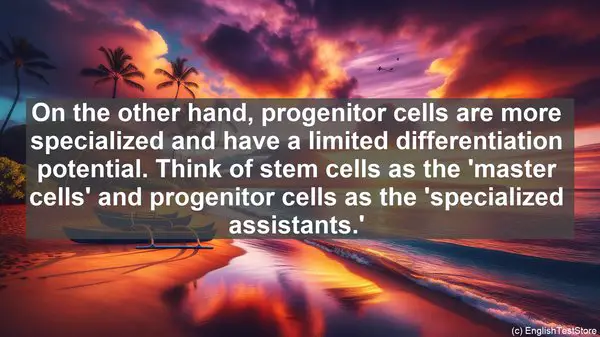Introduction
Today, we’re diving into the world of regenerative biology. As you explore this field, you’ll come across numerous terms that may seem similar but have distinct meanings. In this lesson, we’ll unravel the top 10 commonly confused words in regenerative biology, ensuring you have a solid foundation for your studies. Let’s get started!
1. Stem Cells vs. Progenitor Cells
Stem cells and progenitor cells are often used interchangeably, but they have a fundamental difference. Stem cells are undifferentiated cells capable of self-renewal and differentiation into various cell types. On the other hand, progenitor cells are more specialized and have a limited differentiation potential. Think of stem cells as the ‘master cells’ and progenitor cells as the ‘specialized assistants.’
2. Dedifferentiation vs. Transdifferentiation
Both dedifferentiation and transdifferentiation involve a cell changing its identity, but the process and outcome differ. Dedifferentiation refers to a cell reverting to an earlier, less specialized state. In contrast, transdifferentiation is when a cell directly converts into a different cell type. Dedifferentiation is like going back a few steps, while transdifferentiation is like taking a completely different path.
3. Regeneration vs. Repair
Regeneration and repair are mechanisms by which organisms restore damaged tissues, but they have distinct characteristics. Regeneration involves the regrowth of lost or damaged tissue to its original structure and function. Repair, on the other hand, involves the formation of scar tissue, which may not fully restore the original structure or function. Regeneration is like restoring a painting to its original glory, while repair is like patching it up.
4. Induced Pluripotent Stem Cells (iPSCs) vs. Embryonic Stem Cells (ESCs)
Both iPSCs and ESCs have the ability to differentiate into various cell types, but their origin and applications differ. iPSCs are generated by reprogramming adult cells, such as skin cells, to an embryonic-like state. ESCs, on the other hand, are derived from early-stage embryos. While ESCs have a higher differentiation potential, iPSCs have the advantage of being patient-specific, reducing the risk of rejection in transplantation.

5. Morphogenesis vs. Organogenesis
Morphogenesis and organogenesis are stages in the development of an organism, but they refer to different processes. Morphogenesis is the formation of the organism’s overall shape and structure. Organogenesis, on the other hand, is the specific formation of organs and organ systems. Morphogenesis is like building the frame of a house, while organogenesis is like adding the rooms and fixtures.
6. Differentiation vs. Maturation
Differentiation and maturation are steps in the development of cells, but they have distinct meanings. Differentiation is the process by which a cell becomes more specialized, acquiring specific characteristics and functions. Maturation, on the other hand, refers to the cell reaching its fully functional state. Differentiation is like a student choosing a major, while maturation is like the student graduating and entering the workforce.
7. Blastema vs. Bulge
Both blastema and bulge are involved in tissue regeneration, but they have different roles. Blastema is a mass of undifferentiated cells capable of giving rise to various cell types during regeneration. Bulge, on the other hand, is a region in hair follicles that contains stem cells responsible for hair regeneration. Blastema is like a versatile construction crew, while the bulge is like a specialized team for hair restoration.

8. Epimorphosis vs. Morphallaxis
Epimorphosis and morphallaxis are two modes of tissue regeneration, each with its own characteristics. Epimorphosis is the regrowth of a structure from a group of undifferentiated cells, often involving the formation of a blastema. Morphallaxis, on the other hand, is the remodeling of existing tissues to restore the original structure. Epimorphosis is like rebuilding a house from scratch, while morphallaxis is like renovating and restoring an old house.
9. Homeostasis vs. Regeneration
Homeostasis and regeneration are related but distinct processes in an organism. Homeostasis refers to the maintenance of a stable internal environment, ensuring optimal conditions for cells and tissues. Regeneration, on the other hand, is the ability to replace lost or damaged tissues. Homeostasis is like maintaining a clean and organized room, while regeneration is like fixing or replacing a broken piece of furniture.
10. Growth Factors vs. Cytokines
Both growth factors and cytokines play crucial roles in cell signaling, but they have different functions. Growth factors are signaling molecules that promote cell growth, proliferation, and differentiation. Cytokines, on the other hand, are involved in immune responses and cell communication. Growth factors are like the ‘go’ signals for cell activities, while cytokines are like the messengers conveying important information.
